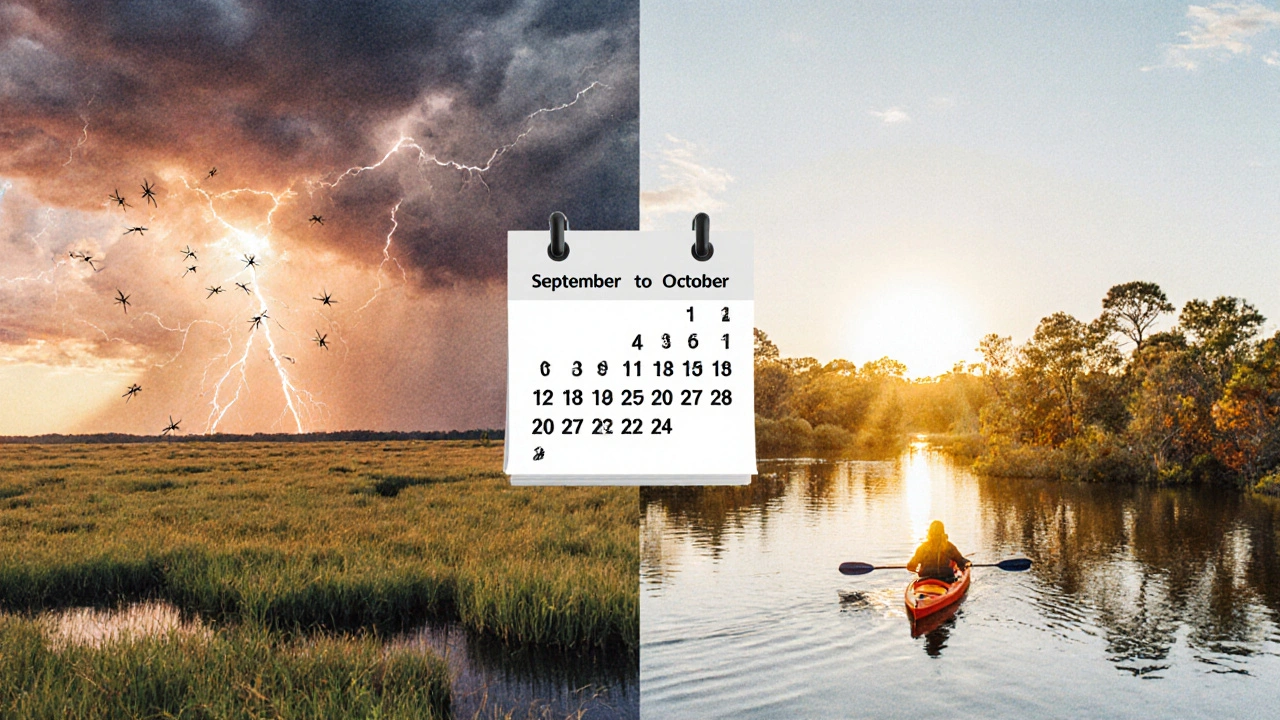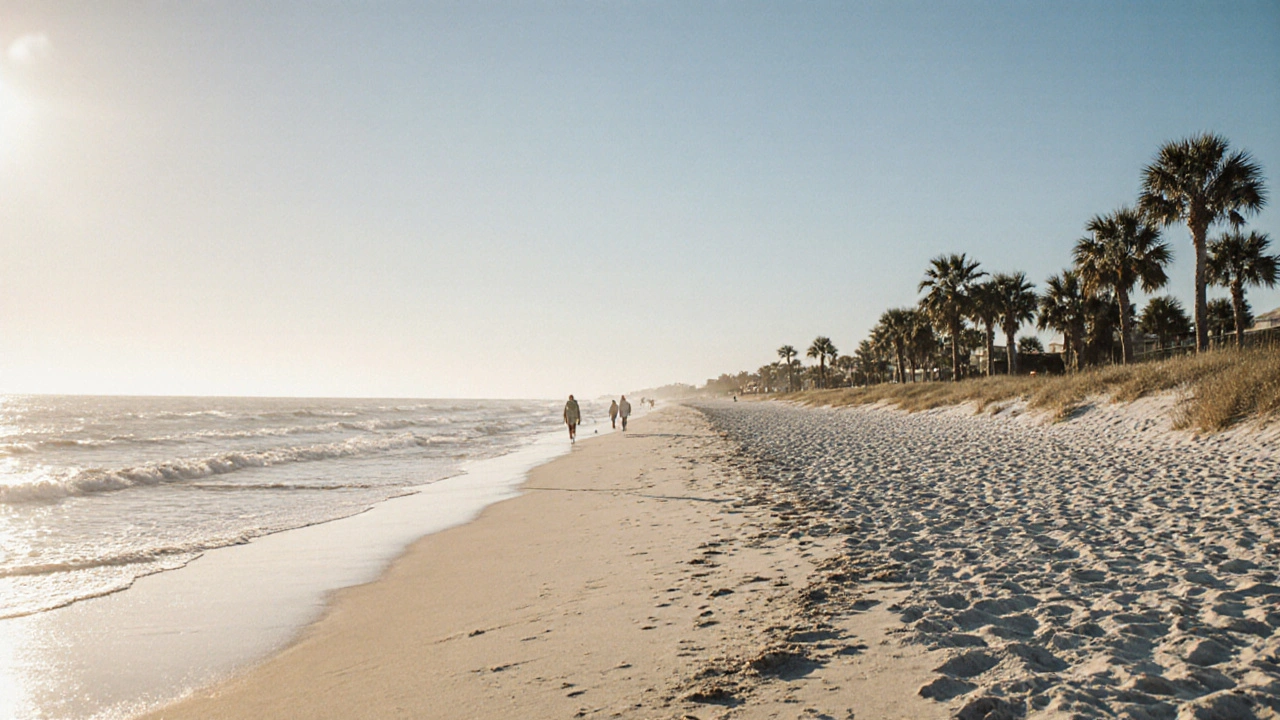Florida isn’t just one place-it’s a mix of beaches, theme parks, swamps, and cities, all with their own rhythms. So asking when the best month to visit Florida is like asking when’s the best time to go to the ocean: it depends on what you’re looking for. Do you want warm water and no lines? Or cheap hotels and quiet streets? Maybe you just want to avoid the sweat and the bugs. Let’s cut through the noise and give you the real answer, month by month.
December to February: The Sweet Spot for Most Visitors
If you’re from the Midwest, Northeast, or Canada, December through February is when Florida shines. Temperatures hover between 65°F and 75°F. It’s dry. The humidity drops. Mosquitoes disappear. And the beaches? Clean, quiet, and perfect for walking without feeling like you’re melting.
This is also when Disney World and Universal Studios see the biggest drop in crowds-after the Thanksgiving rush and before spring break. Hotel rates drop by 20-30% compared to peak season. You can book a beachfront condo in Clearwater for under $150 a night in January, something you’d never see in July.
But here’s the catch: it’s also the most popular time for snowbirds and out-of-state tourists. So while it’s not packed like summer, you’ll still need to book early. And yes, it gets chilly at night-pack a light jacket if you’re heading to the Keys or the Gulf Coast.
March and April: Spring Break Chaos (But Great Weather)
March is when Florida turns into a party. College students flood Daytona Beach, Panama City, and Fort Lauderdale. Orlando’s theme parks hit 90%+ capacity. Hotels double or triple their prices. Parking at Disney? Good luck finding a spot before noon.
But if you can avoid the spring break zones, April is magic. The weather is still perfect-low 80s, low humidity. The water is warm enough for swimming. And by mid-April, the crowds thin out fast. It’s the last sweet spot before summer heat rolls in.
Pro tip: If you’re going to Disney World, aim for the last week of March. The parks are still busy, but the lines start to ease up after March 25. Book your FastPasses the moment they open-60 days in advance if you’re staying on-site.
May: The Hidden Gem
May is Florida’s best-kept secret. The weather is warm but not unbearable-mid-80s, with sea breezes keeping things comfortable. Rain? Maybe an afternoon shower, but rarely all day. Crowds? Almost none. Theme parks are quieter than they’ve been since November.
Hotels are still at off-season rates. Airfares? Lower than in December. And the beaches? You can actually find an empty patch of sand.
This is the month when locals start planning their summer escapes-and you can get the same experience they’ll pay double for in June. The only downside? The humidity starts creeping back. But if you don’t mind a little stickiness, May is the most underrated month to visit Florida.

June to August: Hot, Humid, and Crowded (But Worth It for Some)
Let’s be honest: summer in Florida is not for everyone. Temperatures hit 90°F daily. Humidity hits 90%. Afternoon thunderstorms roll in like clockwork-usually between 2 and 5 p.m. They’re intense, but short. You’ll get soaked, then dry off in 20 minutes.
Theme parks are packed. Disney World averages 60,000 visitors a day in July. Hotels are expensive. And yes, mosquitoes are hungry. But here’s the flip side: this is when Florida’s water parks, beaches, and pools are at their best. The Gulf and Atlantic are warm enough to swim in without shivering.
If you’re traveling with kids and they’re out of school, summer is your only option. And if you’re willing to go early or late, you can beat the worst. Go to the beach at 7 a.m. Hit the park before 10 a.m. Ride the big rides during the storm break. And book a hotel with a pool-your best friend in July.
September: Risky, But Rewarding
September is the wild card. It’s still hot. Still humid. And yes, it’s hurricane season. But it’s also the cheapest time of year to visit Florida. You can find all-inclusive resorts in Fort Myers for under $100 a night. Flights from New York? $150 round-trip.
Theme parks are nearly empty. Disney’s Magic Kingdom might have fewer than 20,000 visitors a day-half of what it sees in July. Lines for Avatar Flight of Passage? Under 30 minutes.
But you need to be smart. Book refundable rates. Get travel insurance. Monitor the National Hurricane Center. If a storm looks like it’s heading your way, leave. But if it doesn’t? You’ve got Florida all to yourself.
Many locals wait until September to visit. The water is warm. The air is still. And the crowds? Gone. It’s not for everyone-but if you’re flexible and lucky, it’s the most valuable time to go.
October and November: Cooling Down, But Still Warm
October is when Florida starts to feel like itself again. The heat fades. The humidity drops. Rain becomes rare. By mid-October, the mosquitoes are gone. The water is still warm enough for swimming.
October is also when the Florida Keys host the annual Key West Literary Seminar and the Everglades National Park kicks off its dry season tours. It’s quiet, but not empty. You’ll find good deals on flights and hotels.
November is even better. Temperatures hover around 75°F. Crowds are light. And the holiday rush hasn’t started yet. It’s the perfect transition month-warm enough for the beach, cool enough for a sunset walk in St. Augustine.
By late November, prices start creeping up. But if you go before Thanksgiving, you’re still in the sweet spot. And if you’re planning a Christmas trip, November is the time to book everything-rooms, rentals, tickets.

What Month Should You Choose?
Here’s the quick breakdown:
- Best overall: December to February-great weather, low crowds, good prices.
- Best value: May or September-low prices, fewer people, decent weather.
- Best for families: April or October-good weather, school breaks, manageable crowds.
- Best for budget travelers: September-lowest prices, empty parks, warm water.
- Avoid if you hate heat: June to August-too hot, too humid, too crowded.
There’s no single “best” month. But if you want the most balanced experience-good weather, low crowds, decent prices-February is your safest bet. It’s the quiet end of peak season. The sun is still strong. The water is warm. And you won’t have to fight for a table at a beachside restaurant.
Frequently Asked Questions
Is it cheaper to visit Florida in the summer?
Yes, but only if you’re okay with extreme heat and high humidity. June through August has the lowest hotel rates, especially in September. But you’ll pay in comfort-thunderstorms daily, sweltering temperatures, and crowded theme parks. If you’re on a tight budget and can handle the conditions, summer is the cheapest time. Otherwise, May or late October offer better value without the misery.
When is the best time to visit Disney World?
The best time is mid-January to early February or mid-September to mid-November. Crowds are lowest, and wait times for rides are under 45 minutes on average. Avoid spring break (mid-March to early April) and summer holidays (late June to early August). If you must go during peak times, book Genie+ early and use the Disney app to track real-time wait times.
Can you swim in Florida in January?
Yes, but it depends on where you are. In the Florida Keys and Miami, ocean water stays around 70°F in January-swimmable for most people. On the Gulf Coast, it drops to 65°F, which feels chilly but is fine for short dips. If you’re planning to swim daily, choose southern Florida. Northern beaches like Jacksonville are too cold for comfortable swimming until April.
What’s the rainiest month in Florida?
June through September are the wettest months, with August being the peak. Most rain comes in short, heavy afternoon thunderstorms-usually lasting less than an hour. It rarely rains all day. The dry season runs from November to April, when rainfall drops to under 2 inches per month. If you’re planning outdoor activities, stick to the dry season for reliable weather.
Is Florida safe to visit during hurricane season?
Yes, but you need to be prepared. Hurricane season runs from June 1 to November 30. Major hurricanes hitting Florida are rare-on average, one every 5-7 years. Most storms pass offshore or weaken before landfall. Check the National Hurricane Center daily if you’re visiting in August or September. Book refundable accommodations and buy travel insurance. If a storm is forecasted, you can usually cancel or reschedule without penalty.
Next Steps
Decide what matters most to you: weather, cost, crowds, or activities. Then pick your month. If you want to relax on the beach, go in February. If you’re chasing deals and don’t mind heat, try September. If you’re taking kids to Disney, aim for April or October. No month is perfect-but every month has its advantage. The key is matching your priorities to the season.

